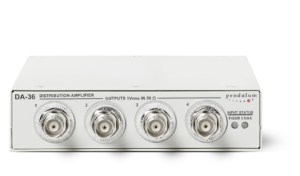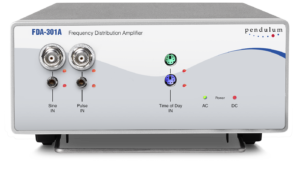Overview
The Pendulum Frequency Distribution Amplifiers, FDA-301 and DA-36, offer an economical solution to low-jitter and long-range distribution of Frequency Reference and/or Time Synchronization Signals.
The versatile and modular FDA-301 can distribute sine reference frequencies and time synchronization signals (1-pps and unmodulated IRIG) from a central source to up to 18 remote sites (point-to-multipoint). Additionally it can distribute serial Time-of-Day messages (NMEA or user defined code) and telecom sync signals (E1/T1 clock/data)
The small and low-cost DA-36 can distribute a sine reference frequency to 1 remote site (point-to-point), and is an excellent electrical to optical converter or optical to electrical converter.
The DA-36 will interface directly to FDA-301, and FDA-301 can be a drop-in replacement in current DA-36 (or legacy DA-35) networks. A distribution system can be designed with a mix of DA-36 and FDA-301, for example distribution to only one remote site (DA-36), with several local users (FDA-301).
Benefits
Both models use coax cables for local distribution and optical fibers for remote distribution, giving the following benefits for fiber:
- Distribution of reference frequencies up to 2 km
- Galvanic isolation, eliminate ground current loop problems
- Low-loss distribution
- No crosstalk, no electromagnetic noise and interference pick-up
- Easy to install – flexible, lightweight and small-diameter optical fiber

DA-36
DA-36 Point-to-Point Distribution Amplifier for reference frequency signals The Distribution Amplifier DA-36 solves the problem of distributing a reference frequency from a central frequency standard to one or several receiving points. It offers frequency distribution via optical fiber, or coax … Continued

FDA-301A
FDA-301A Point-to-Multi-point Distribution Amplifier for reference frequency and time synchronization signals The Time & Frequency Distribution Amplifier FDA-301A is a very versatile fiber and coax Distribution Amplifier designed to distribute various signal types from a central frequency standard, and/or a … Continued